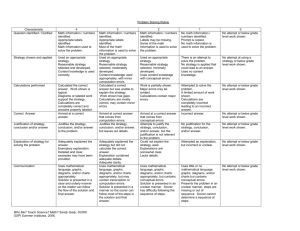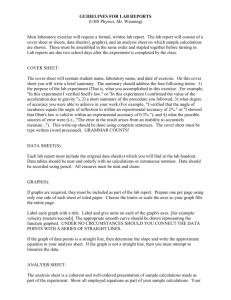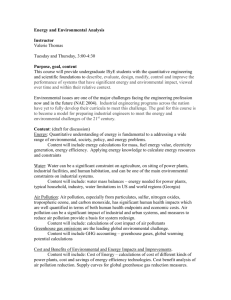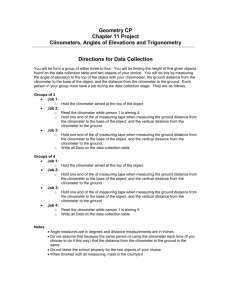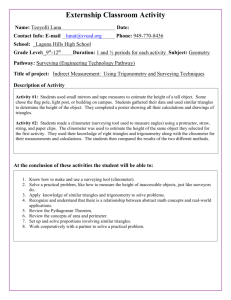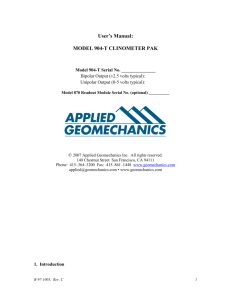Jasper Geometry Clinometer Project
advertisement
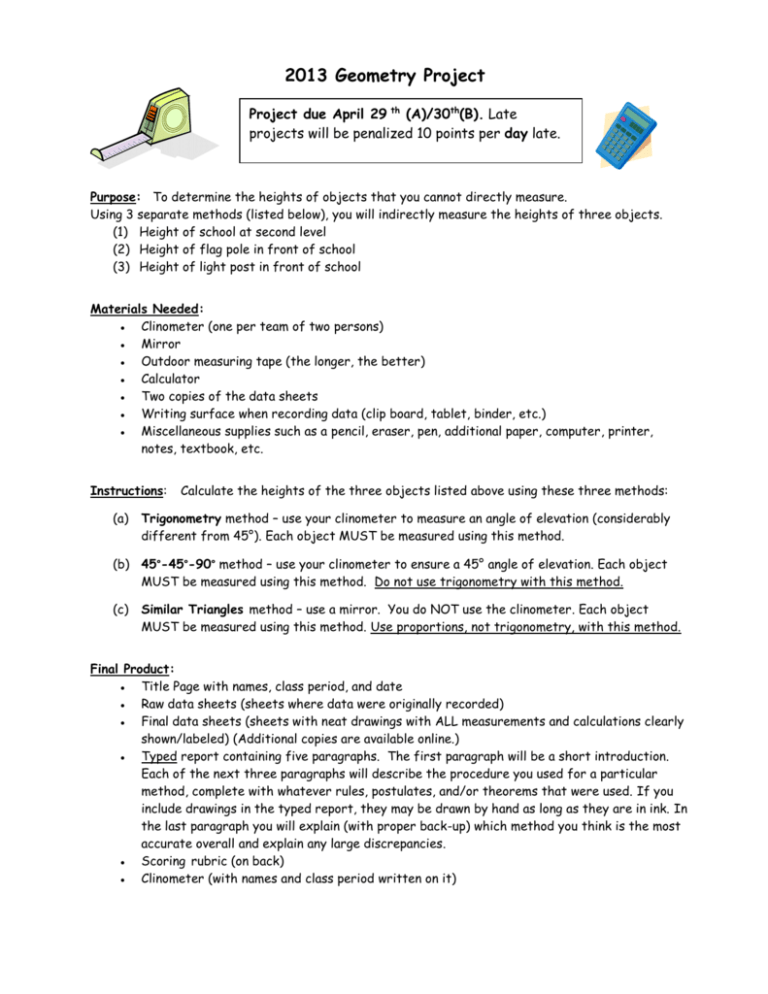
2013 Geometry Project Project due April 29 th (A)/30th(B). Late projects will be penalized 10 points per day late. Purpose: To determine the heights of objects that you cannot directly measure. Using 3 separate methods (listed below), you will indirectly measure the heights of three objects. (1) Height of school at second level (2) Height of flag pole in front of school (3) Height of light post in front of school Materials Needed: ● Clinometer (one per team of two persons) ● Mirror ● Outdoor measuring tape (the longer, the better) ● Calculator ● Two copies of the data sheets ● Writing surface when recording data (clip board, tablet, binder, etc.) ● Miscellaneous supplies such as a pencil, eraser, pen, additional paper, computer, printer, notes, textbook, etc. Instructions: (a) Calculate the heights of the three objects listed above using these three methods: Trigonometry method – use your clinometer to measure an angle of elevation (considerably different from 45°). Each object MUST be measured using this method. (b) 45°-45°-90° method – use your clinometer to ensure a 45° angle of elevation. Each object MUST be measured using this method. Do not use trigonometry with this method. (c) Similar Triangles method – use a mirror. You do NOT use the clinometer. Each object MUST be measured using this method. Use proportions, not trigonometry, with this method. Final Product: ● Title Page with names, class period, and date ● Raw data sheets (sheets where data were originally recorded) ● Final data sheets (sheets with neat drawings with ALL measurements and calculations clearly shown/labeled) (Additional copies are available online.) ● Typed report containing five paragraphs. The first paragraph will be a short introduction. Each of the next three paragraphs will describe the procedure you used for a particular method, complete with whatever rules, postulates, and/or theorems that were used. If you include drawings in the typed report, they may be drawn by hand as long as they are in ink. In the last paragraph you will explain (with proper back-up) which method you think is the most accurate overall and explain any large discrepancies. ● Scoring rubric (on back) ● Clinometer (with names and class period written on it) Grading: Highlight all answers. Round all final heights to the nearest tenth of a foot. Working with another group or using any data other than your own will result in a zero. This project counts as a test grade. The project will be graded using the following rubric. Points Data Sheet (72) 9 individual pictures with measurements and calculations, each worth 8 points. Above Average Average Below Average Diagrams and calculations are mostly understandable, but may contain minor errors. Diagrams labeled (2) Calculations mostly accurate* (4) Diagrams and calculations are understandable, but may contain major errors. Diagrams labeled (1) Device is calibrated, accurate and attached (8) Device is not calibrated, inaccurate but attached (5) Device is not attached-missing (0) Geometric language is used appropriately and correctly. Postulates or theorems are accurately used to explain methods. Most of the geometric language is used appropriately and correctly. Most postulates and theorems are used accurately to explain methods. Geometric terms are not used or often misused. Some postulates and theorems are used accurately to explain methods. No geometric terms are used. Postulates and theorems are not used to explain methods. Introduction (1) Trig (5) 45-45-90 (5) Similar Triangles (5) Summary (4) Introduction (1) Trig (4) 45-45-90 (4) Similar Triangles (4) Summary (3) Introduction (1) Trig (2) 45-45-90 (2) Similar Triangles (2) Summary (2) Introduction (0) Trig (0) 45-45-90 (0) Similar Triangles (0) Summary (0) Diagrams and calculations are clear, complete and accurate. Diagrams labeled (4) Calculations accurate* (4) Clinometer (8) Reports (20) The introduction is worth 1 point, each of the three method paragraphs is worth 5 points, and the summary is worth 4 points. Calculations inaccurate* (2) Poor Diagrams and calculations are inaccurate, incomplete and unclear. Major elements are missing. Diagrams not label (0) Calculations missing (0) TOTAL (100) *Note: Points will be automatically deducted for large errors in the final heights. Each height that has an error greater than 3 feet but less than or equal to 6 feet will earn a maximum of 2 points and those with errors greater than 6 feet will earn no credit for the accuracy component of the grade. Total score __________________

